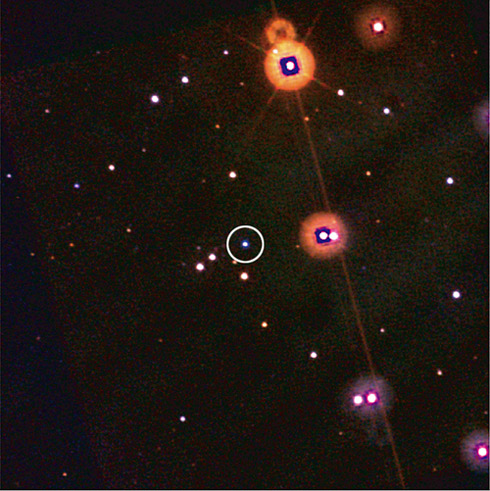Key Takeaways:
A weak but abnormally long-lasting gamma-ray burst (GRB) has given astronomers an unprecedented start-to-finish view of an exploding star. Ground- and space-based telescopes studied the blast in detail at gamma-ray through radio wavelengths. In addition, scientists suspect such weak bursts may outnumber their more powerful brethren by as much as 10 to 1.
“Usually, these events are not detected until after the supernova has brightened substantially in the optical wavelength, many days after the initial explosion,” says Keith Mason, lead researcher on Swift’s Ultraviolet/Optical Telescope. “But on this occasion, we were able to study the remarkable event in all its glory from the very beginning.”
“This object tells us that there probably is a rich diversity of cosmic explosions … we only now are starting to detect,” says Dale Frail of the National Radio Astronomy Observatory.
The burst, designated GRB 060218, lasted about 35 minutes — about 100 times longer than typical bursts associated with supernovae. It was also just 1 percent the brightness of GRBs seen in the distant universe, which places it in a subclass known as X-ray flashes. Although weak as GRBs go, the burst still shone with 10 million billion times the Sun’s power, O’Brien says.
After two-and-a-half minutes, Swift’s telescopes identified the blast’s X-ray and ultraviolet counterparts. They coincided with a dwarf galaxy about 470 million light-years away. This places GRB 060218 some 25 times closer than typical GRBs. In fact, it’s one of the closest on record, second only to GRB 980425 (117 million light-years), which erupted before Swift’s launch.
“We were able to see it because it’s relatively nearby,” says Caltech’s Alicia Soderberg. Her research team, which includes Frail, investigated the object using the Very Large Array radio telescope in New Mexico, England’s Ryle radio telescope, and NASA’s orbiting Chandra X-ray Observatory.
Astronomers think long GRBs to form when a massive star that has shed its outermost layers collapses to form a black hole. A disk of material near the hole launches powerful jets that rip through the star and create a long gamma-ray burst as the high-energy matter interacts with gas the star ejected. Days later, astronomers may detect the expanding star itself.
“We think that the principal difference between gamma-ray bursts and X-ray flashes and ordinary supernova explosions is that the blasts that produce gamma rays and X-rays have disks of material rotating rapidly about the central object,” explains Soderberg. The less-powerful X-ray flashes may herald the birth of a neutron star, possibly even a supermagnetic variety called a magnetar.
Swift’s three telescopes — covering gamma ray, X-ray, ultraviolet and visible wavelengths — captured the rapid changes in the object’s emissions. “The results suggest a broad jet expanded into the surroundings, but it was accompanied by a slower-moving and incredibly hot … bubble of gas produced from the shockwave of the exploding star,” O’Brien says.
Radio observations helped astronomers determine the blast’s geometry. “We find that, unlike typical GRBs, which produce pencil-beam jets, this object more resembles a spherical explosion,” Soderberg says.
Astronomers from Italy’s National Institute for Astrophysics and England’s universities of Leicester and Hertfordshire used the European Southern Observatory’s Very Large Telescope in Chile and the Lick Observatory’s Shane Telescope in California to sample the object’s visible spectrum regularly.
On February 20, two days after the GRB, a brightening type Ic supernova began to outshine the fading shockwave. Astronomers designated the blast SN 2006aj.
“The supernova associated with this GRB is a transition object, brighter than most supernovae in the universe, but fainter than those previously seen with GRBs,” says Andrew Levan at the University of Hertfordshire. “Understanding the reasons for this is a crucial step in understanding why only a small percentage of massive stars can create GRBs.”
Alex Filippenko at the Universtiy of California, Berkeley, thinks the star originally had a mass of about 20 Suns. Stars less massive than this are thought to form neutron stars, not black holes. This star could have gone either way, he says. By the time the star exploded, it had shed all but 3 or 4 solar-masses.
“Because massive stars are hard to form,” Filippenko says, “there may be many more supernovae like this producing X-ray flashes than explosions of very massive stars to produce gamma-ray bursts.”
The scientists report their findings in four papers appearing in this week’s issue of Nature.










